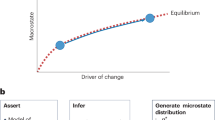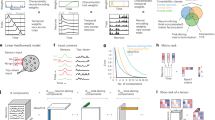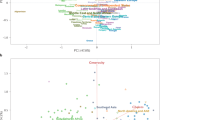Abstract
A LINEAR relation has sometimes to be established between two observed quantities, the precision of each observed value for both quantities being limited and variable from value to value in some known way. Examples in astronomy may be found in the treatment of proper motions in moving clusters, in the evaluation of solar motion by proper motions, and in the evaluation of the linear terms of galactic rotation in the solar neighbourhood. In such cases the line through the intersection of the two regression lines, with a slope equal to the geometric mean of the slopes of the two regression lines, may often be a good estimate of the best linear relation, but it does not seem to be a least-squares solution in a precise sense. Seares1 discusses at length the best estimates of the regression lines that can be set up, taking into account varying weight for each value and the effect on the regression lines of the distribution of the observed values about the diagram. His best linear relation is evaluated as the weighted geometric mean of the two regression lines and he shows2 that in the case of uniform precision in each quantity his solution reduces to that obtained by Hertzsprung3 to cover this particular case. It would seem, however, that generalization of Hertzsprung's result to cases of varying precision should be possible without bringing in the regression lines at all. Jeffreys4 apparently gives such a solution (his equation 5, § 4.42), but in fact, as was pointed out to me by Dr. A. J. Wesselink, his solution reduces to one of the usual regression lines in the case of uniform precision and not to Hertzsprung's solution. Trumpler and Weaver5 mention several times the importance of ‘two-error’ least squares solutions in astronomy but nowhere make a solution.
This is a preview of subscription content, access via your institution
Access options
Subscribe to this journal
Receive 51 print issues and online access
$199.00 per year
only $3.90 per issue
Buy this article
- Purchase on Springer Link
- Instant access to full article PDF
Prices may be subject to local taxes which are calculated during checkout
Similar content being viewed by others
References
Seares, F. H., Astrophys. J., 100, 255 (1944).
Seares, F. H., Astrophys. J., 102, 366 (1945).
Hertzsprung, E., Leiden Ann., XIV, Eerste Stuk (1922).
Jeffreys, H., “Theory of Probability”, 164 (Oxford University Press, 1939).
Trumpler, R. J., and Weaver, H. F., “Statistical Astronomy” (Univ. of California, 1953).
Author information
Authors and Affiliations
Rights and permissions
About this article
Cite this article
WAYMAN, P. A Least-Squares Solution for a Linear Relation between Two Observed Quantities. Nature 184, 77–78 (1959). https://doi.org/10.1038/184077a0
Issue Date:
DOI: https://doi.org/10.1038/184077a0
This article is cited by
-
Phylogenetic and recombination analysis of rice black-streaked dwarf virus segment 9 in China
Archives of Virology (2015)
-
Identification of significant single nucleotide polymorphisms for resistance to maize rough dwarf disease in elite maize (Zea mays L.) inbred lines
Euphytica (2015)
-
Identification and fine-mapping of a QTL, qMrdd1, that confers recessive resistance to maize rough dwarf disease
BMC Plant Biology (2013)
-
Identification of a major quantitative trait locus for resistance to maize rough dwarf virus in a Chinese maize inbred line X178 using a linkage map based on 514 gene-derived single nucleotide polymorphisms
Molecular Breeding (2012)
-
Fitting ν Linear Relations to n Variables all liable to Error
Nature (1960)
Comments
By submitting a comment you agree to abide by our Terms and Community Guidelines. If you find something abusive or that does not comply with our terms or guidelines please flag it as inappropriate.



